While the devastating impact of the second Covid-19 on public health in India is well-known, there is relatively little evidence on its economic and psychological dimensions. Based on surveys in industrial clusters of Delhi, Afridi et al. examine the dynamic effects of the different phases of the pandemic to date, on livelihoods and mental health of poor, informal workers – and how the experiences of women and men compare.
In two previous I4I posts (Afridi et al. 2020a, Afridi et al. 2020b), we reported findings of follow-up phone surveys – from a Delhi-based survey1 of primarily informal-sector workers that began in May 2019 – conducted during the nationwide Covid-19 lockdown (announced on 24 March), between 3 April and 2 May 2020. Our initial findings included data from the most stringent period of the lockdown, that is, Phase 1 of the lockdown which lasted until 19 April. We followed up with the findings using data from Phase 2 of the lockdown – following some easing of restrictions – from 20 April to 3 May 2020.
Since then, we have conducted two further rounds of surveys with these respondents: (i) August-October 2020 (a phone survey after the nationwide lockdown was relaxed) and (ii) April-June 2021 (during the recent second wave of the pandemic and accompanying localised lockdowns). Forty-three per cent of the last survey round was conducted in-person until mid-April 2021, after which we switched to using a phone survey as curfew was imposed in Delhi on 19 April 2021. Despite the circumstances, our re-interview rate has been high – over 92% of the baseline respondents have been surveyed in all phases – except during the nationwide lockdown in the first wave, during which we were able to reconnect with 88% of the baseline households.
Our study gives us a unique perspective into the dynamic effects of the pandemic on poor and informal sector workers, who constitute one of the most vulnerable sections of our population. In addition, since we conducted a matched husband-wife survey, we are able to document the experiences of both women and men during the Covid-19 crisis, within the same households. In particular, we examine the relative impact of the various phases of the pandemic over the past two years, on the earnings, incomes, and mental health of our respondents – and how the experiences of women and men compare at a certain point of time and over time.
Livelihoods: How have unemployment and earnings fared over the past two years?
The nationwide lockdown in 2020 was a massive shock to the livelihoods and wage earnings of these families (Figure 1). As expected, the vast majority of male workers in these residential areas were completely unable to work. Consistently, around 85% of the male respondents did not earn any income from their main occupation. This situation eased over time, as the responses post-lockdown in 2020 suggest, with the relaxing of some restrictions, suggesting that many of these job losses were temporary. However, the recovery was not complete – employment levels did not return to the pre-pandemic levels of 2019. Seventy-seven per cent of male respondents report working after the Covid-19 first wave lockdown, 14 percentage points (pp) lower than in 2019.
Figure 1. Men’s current working status, by survey rounds
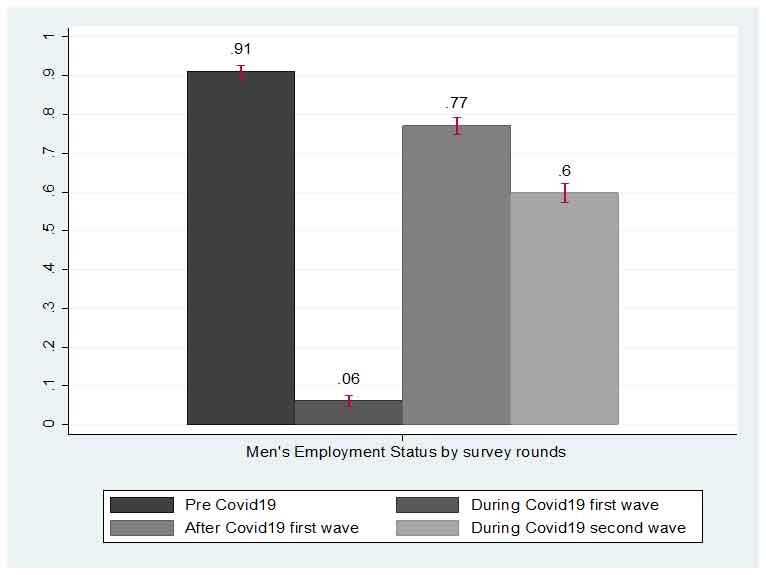
Note: The survey periods are: Pre-Covid-19 (May-July 2019), during Covid-19 first wave (April-May 2020), after Covid-19 first wave (August-October 2020), and during Covid-19 second wave (April-June 2021).
The second wave of the pandemic in 2021 again reduced employment but due to the localised nature of the lockdown and its lower stringency, its implications for employment and earnings are not as adverse as during the 2020 lockdown. Men’s employment fell by 17 pp in 2021 as against 85 pp in the previous survey round in 2020. However, the recovery in the period after the first wave, to the pre-pandemic levels, has reversed to some degree.
We should, however, be cognisant of the fact that uncertainty was much higher during the national lockdown in 2020 as workers were unsure of whether their job losses were permanent or temporary. In the second wave of the pandemic, not only were lockdowns more localised and less stringent, they were also largely expected to be temporary. These factors could have exacerbated the differential impact of the two waves on reported working status2.
Next, we report working status by pre-Covid (2019) occupation (Figure 2). Casual workers were the worst affected during the lockdown in the first wave, with almost none reporting that they were working, as opposed to 6% of self-employed and 10% of salaried workers who reported working. Recovery in the period after the first wave was higher for salaried workers – 81% reported currently working, as against 78% and 75% of self-employed and casual workers, respectively after the Covid-19 first wave. In the second wave, employment among casual workers falls by 24 pp, compared to 18 pp among the self-employed, and 14 pp among salaried workers.
Figure 2. Men’s current working status, by pre-Covid-19 occupation
Consequently, the reported loss of monthly earnings is also lower in the second wave of the pandemic – Rs. 1,300 rupees compared to over Rs. 10,000 in the first lockdown (Figure 3)3. But the gap in earnings between the pre- and pandemic period has worsened, on account of the second wave.
Figure 3. Men’s monthly earnings, by survey rounds
Although we obtained employment data for both women and men in 2019, during the lockdown in 2020, we were able to gather data on livelihoods only for male respondents. Hence, we have information on four rounds of employment data for the male respondents and three rounds (excluding the national lockdown of 2020) for women.
In contrast to men, whose current working status falls significantly, women’s employment remains stable during the period between the two waves and the second wave of the pandemic, at approximately 11%-13% (Figure 4). Similar to men, women’s employment levels do not return to the pre-Covid level of 21% – remaining 10 pp lower after the Covid-19 first wave, and 8 pp during the second wave.
Figure 4. Women’s current working status, by survey rounds
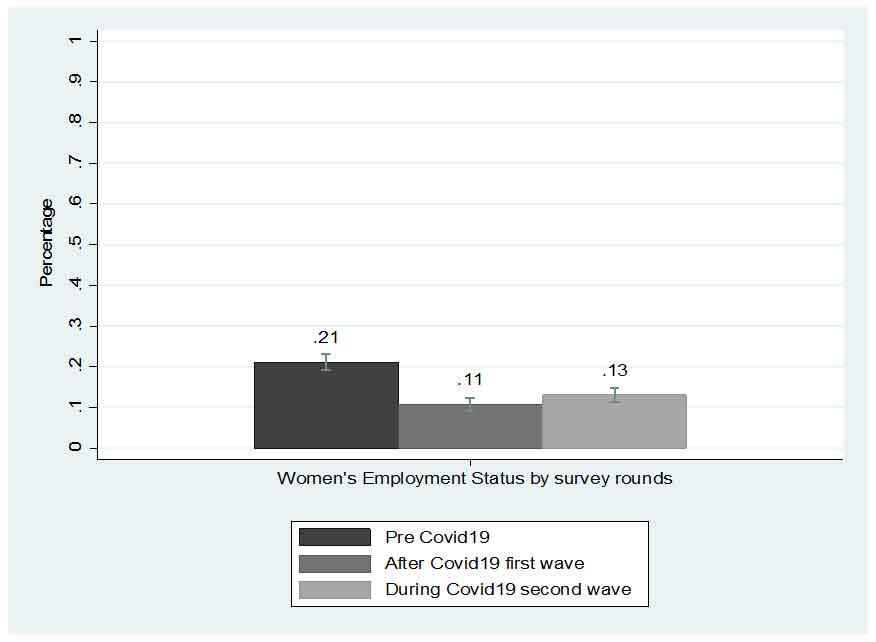
Note: The survey periods are: Pre-Covid-19 (May-July 2019), during Covid-19 first wave (April-May 2020), data of which are unavailable for women’s current working status, after Covid-19 first wave (August-October 2020), and during Covid-19 second wave (April-June 2021).
This holds true when we analyse current working status by pre-Covid-19 occupation categories as well (Figure 5). Unlike men, whose current working status falls between August-October 2020 and the recent second wave of the pandemic, more women report working in each occupation category between these two periods.
Figure 5. Women’s current working status, by pre-Covid-19 occupation
Consequently, there is a small and statistically insignificant increase in women’s monthly earnings between the last two survey rounds, although it remains low relative to their earnings reported in 2019 (Figure 6).
Figure 6. Women’s monthly earnings, by survey rounds
While men’s working status falls by 14 pp between the pre-Covid period and after the stringent lockdown in 2020, women’s working status shrinks by 10 pp. Relative to pre-Covid levels, men’s working status is 31 pp lower, while women’s working status is 8 pp lower. During the period between the two waves and during the second wave (that is, between August-October 2020 and April-June 2021), men’s working status falls by 17 pp, while that of women rises by almost 2 pp.
As a result, the gender gap in working status has shrunk – from 70 pp in the pre-Covid period to 47 pp during the second wave of the pandemic. This suggests that some women were compelled to enter the labour market or continue working under the adverse conditions between these two waves, while men lost jobs. Consequently, the average earnings gap (unconditional on working) also declines by almost Rs. 4,000 – from Rs. 10,256 in the pre-Covid period to Rs. 6,048 during the second wave. These results line up with literature on the countercyclical4 nature of women’s labour supply, and evidence on women’s participation in MNREGA (Mahatma Gandhi National Rural Employment Guarantee Act)5 in rural areas during the first wave of the pandemic (Afridi, Mahajan and Sangwan 2021).
Mental health: Has psychological stress worsened or improved since the pandemic began?
Since the first wave of the pandemic in April 2020, we have documented high levels of psychological stress among our respondents – an often-neglected aspect of the ongoing crisis. We continued to ask our respondents about their emotional status in the four rounds of the survey.
Financial insecurity was the most important source of stress for men at the beginning of the pandemic and continues to dominate over the last year (Figure 7). However, health concerns are now at par with financial concerns in the second wave – 93% of respondents reported health concerns, which is an increase of 9 pp from the 84% reported during the first wave. Hence, while financial concerns remain, health worries have heightened as the pandemic has progressed. We attribute this to the devastating second wave that saw India (and Delhi in particular) record consistently high daily figures of Covid-19 infections and deaths for weeks, due to the highly infectious Delta variant of the Virus, accompanied by the collapse of the healthcare system. Not surprisingly, we also observe a significant increase in depression and anxiety, while reported sleep disorders remain more or less the same.
Figure 7. Men’s mental health, by survey rounds
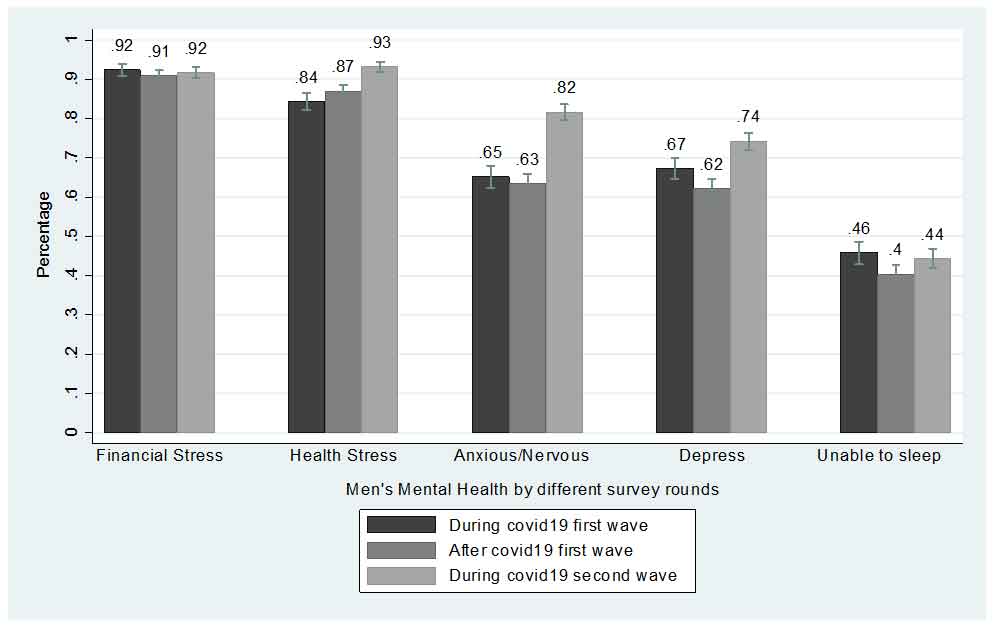
Note: The survey periods are: During Covid-19 first wave (April-May 2020), After Covid-19 first wave (August-October 2020), During Covid-19 second wave (April-June 2021).
We observe similar responses by women (see Figure 8 below) – high financial stress accompanied by an increase in health stress, anxiety, and depression. Unlike men, however, women also report an increase in sleep disorders from 49% during the first wave, to 53% during the second wave.
Figure 8. Women’s mental health, by survey rounds
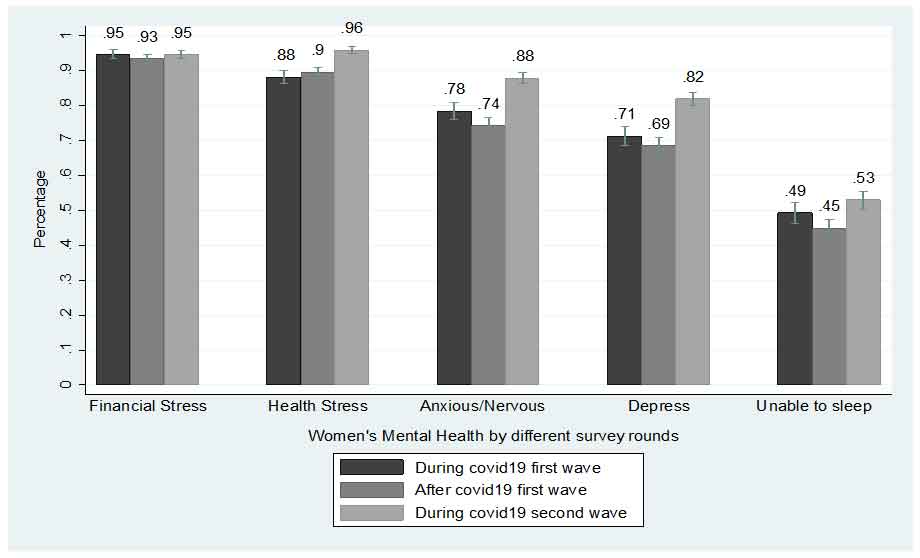
Note: The survey periods are: During Covid-19 first wave (April-May 2020), After Covid-19 first wave (August-October 2020), During Covid-19 second wave (April-June 2021).
In each survey wave, women’s mental well-being is significantly worse than men’s, with more women reporting emotional concerns than men. This gender gap has increased for depression and sleep disorders, significantly for the latter.
Summary
Our surveys document the changes in the economic and psychological well-being of some of the most vulnerable sections of Indian society. We find that the economic shock during the recent devastating second wave of the pandemic, is not as high as during the national lockdown of 2020. However, the labour market is yet to recover to its pre-pandemic levels, suggesting concerns about the longer term impacts on poverty and vulnerability as the pandemic rages on. Recovery has stalled – if not reversed – and significant, urgent public transfers are needed to stem the slide further.
Even though the economic shock has been lower in the second wave, its psychological toll has been higher than at the beginning of the pandemic, particularly as health concerns have been heightened. The adverse effect on emotional well-being has not only persisted and remained high over the past year but appears to be worsening – potentially impacting the long-run productivity of these workers, slowing economic recovery further.
This note has been posted in collaboration with The Wire.
I4I is now on Telegram. Please click here (@Ideas4India) to subscribe to our channel for quick updates on our content.
Notes:
- The survey was conducted with a random sample, consisting of low-income families in industrial areas, of over 3,000 men and women residing in about 1,500 households.
- In all survey rounds, except ‘during Covid-19 first wave’, a person is considered employed if they report that they are currently working. ‘During Covid-19 first wave’, a person is considered employed if the number of days worked after 24 March 2020 was not zero, the income earned was positive, or the respondent reported travelling for work currently.
- ‘During Covid-19 first wave’ survey, male respondents were asked to report their total earnings from the first day of the 2020 nationwide lockdown till the date of the survey. In order to make this comparable with other survey rounds we calculated income per day and multiplied it by 30 to derive monthly earnings.
- Countercyclical refers to being contrary to or tending to counteract the fluctuations in an economic cycle.
- MNREGA guarantees 100 days of wage-employment in a year to a rural household whose adult members are willing to do unskilled manual work at the prescribed minimum wage.
Further Reading
- Afridi, F, K Mahajan and N Sangwan (2021), ‘Employment Guaranteed? Social Protection During a Pandemic’, IZA Discussion Paper 14099.
- Afridi, F, K Mahajan and N Sangwan (2021), ‘Did MNREGA cushion job losses during the pandemic’, Ideas for India, 11 February.
- Afridi, F, A Dhillon and S Roy (2020a), ‘How has Covid-19 crisis affected urban poor? Findings from a phone survey - I’, Ideas for India, 23 April.
- Afridi, F, A Dhillon and S Roy (2020b), ‘How has Covid-19 crisis affected urban poor? Findings from a phone survey - II’, Ideas for India, 11 May.




 02 July, 2021
02 July, 2021 






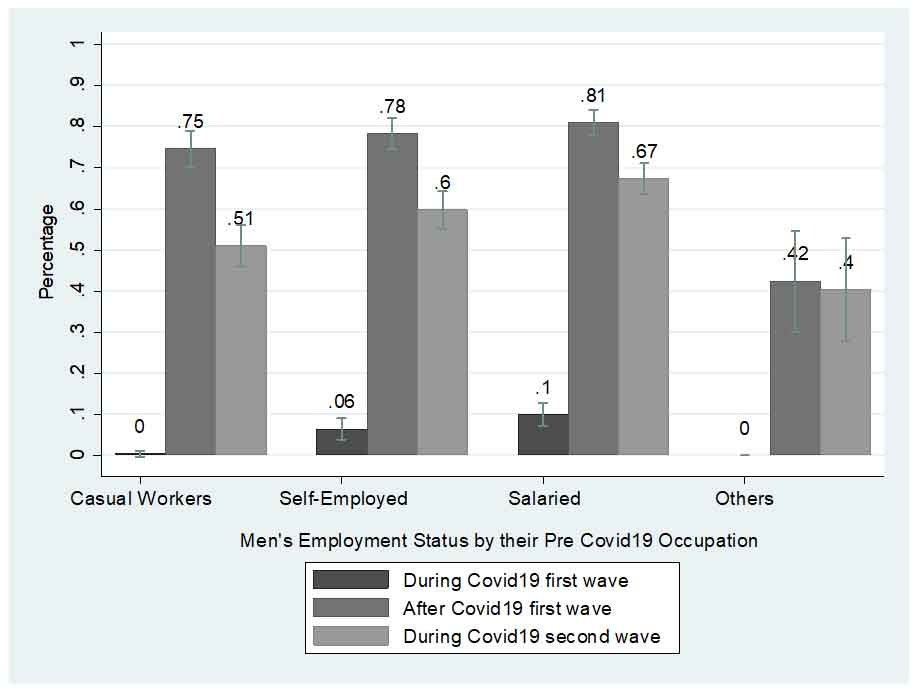
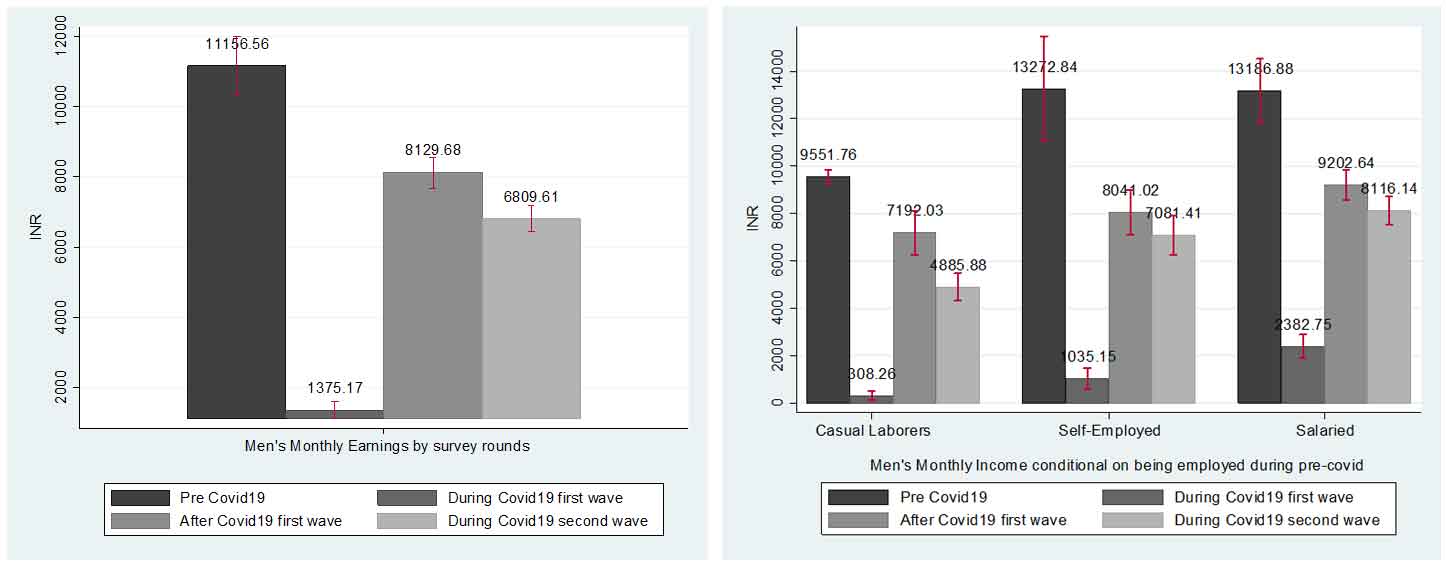
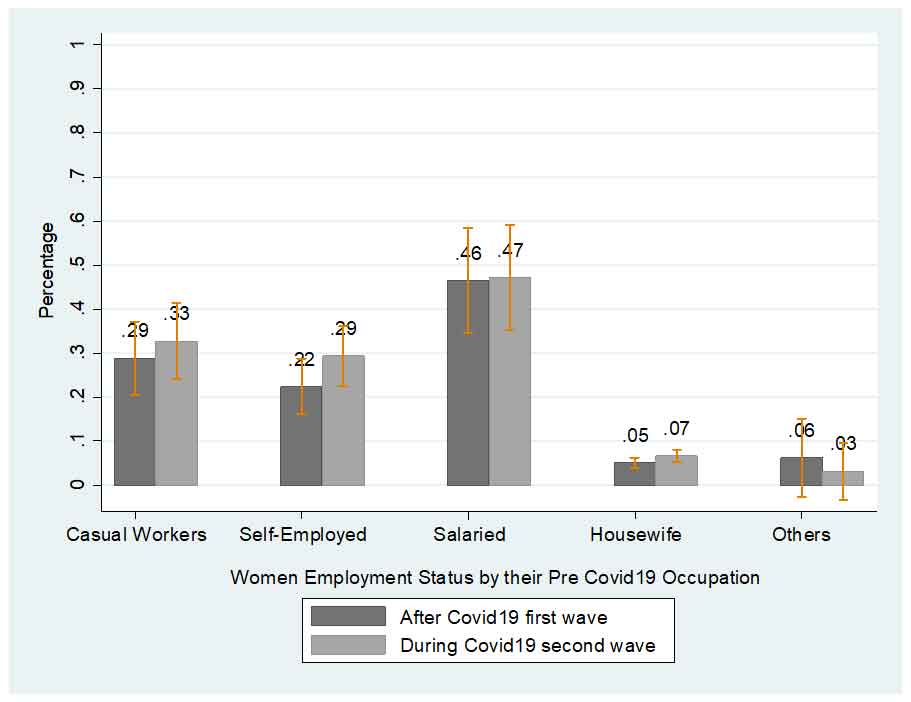
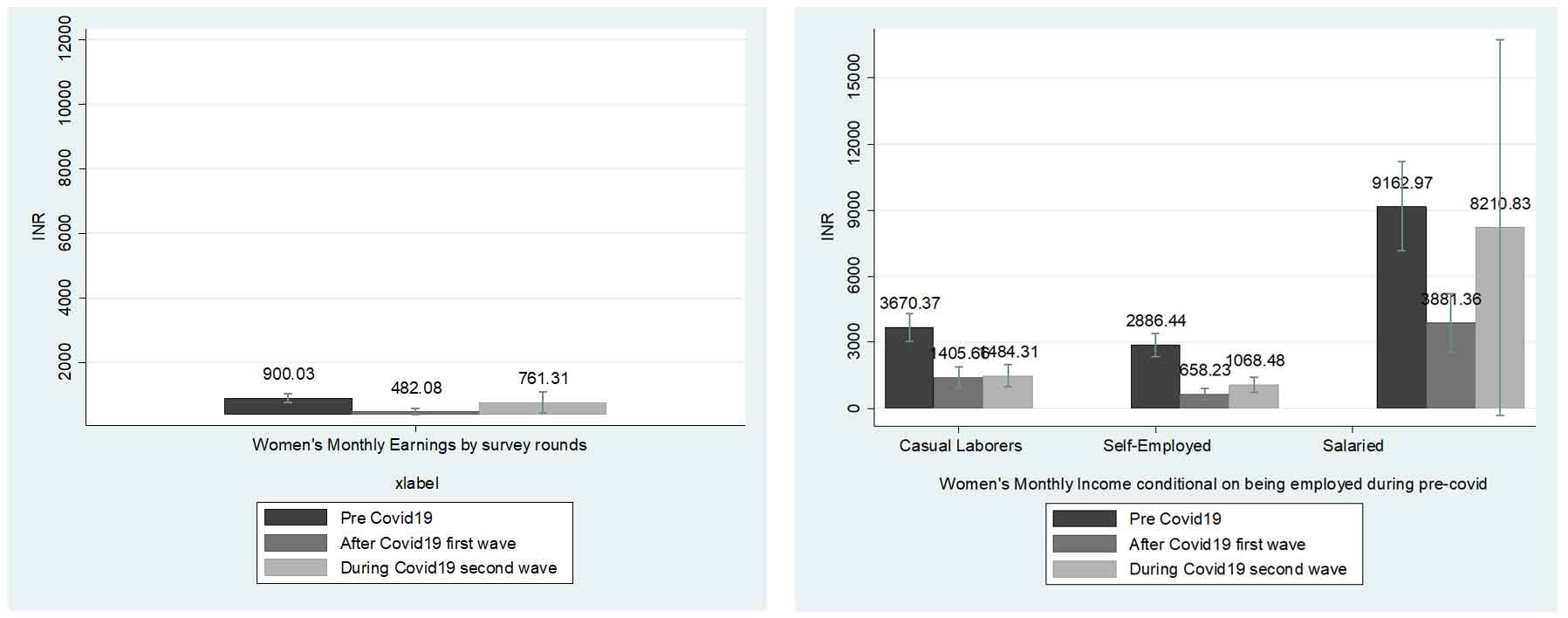
Comments will be held for moderation. Your contact information will not be made public.